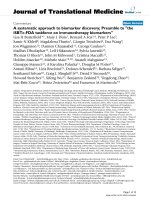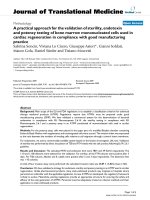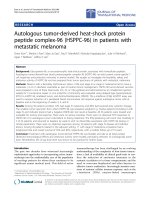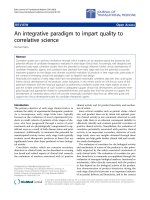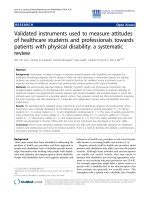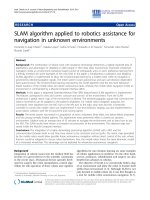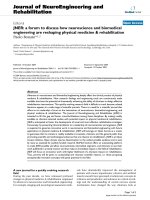Báo cáo hóa học: " Validated instruments used to measure attitudes of healthcare students and professionals towards patients with physical disability: a systematic review" pdf
Bạn đang xem bản rút gọn của tài liệu. Xem và tải ngay bản đầy đủ của tài liệu tại đây (260.49 KB, 7 trang )
RESEA R C H Open Access
Validated instruments used to measure attitudes
of healthcare students and professionals towards
patients with physical disability: a systematic
review
Wai Yim Lam
1
, Sameer K Gunukula
2
, Denise McGuigan
2
, New Isaiah
3
, Andrew B Symons
2
, Elie A Akl
2,3,4*
Abstract
Background: Instruments to detect changes in attitudes towards people with disabilities are important for
evaluation of training programs and for research. While we were interested in instruments specific for medical
students, we aimed to systematically review the medical literature for validated survey instruments used to
measure attitudes of healthcare students and professionals towards patients with physical disability.
Methods: We electronically searched Medline, EMBASE, PsycINFO, Health and Psychosocial Instruments. We
included papers reporting on the development and/or validation of survey instruments to measure attitudes of
healthcare students and professionals towards patients with physical disability. We excluded papers in which the
attitudes were not measured in a provider-patient context. Two reviewers carried out titles and abstracts screening,
full texts screening, and data abstraction in a duplicate and independent manner using standardized and pilot
tested forms.
Results: We ident ified seven validated survey instrum ents used for healthcare students and professionals. These
instruments were originally developed for the following target populations: general population (n = 4); dental
students (n = 1); nursing students (n = 1); and rehabilitation professionals (n = 1). The types of validity reported for
these instruments were content validity (n = 3), criterion-related validity (n = 1), construct validity (n = 2), face
validity (n = 1), discriminant validity (n = 1), and responsiveness (n = 1). The most widely validated and used tool
(ATDP) was developed in the late 1960s while the most recent instrument was developed in the early 1990s.
Conclusion: Of the seven identified validated instruments, less than half were specifically designed for healthcare
students and professionals and none for medical students. There is a need to develop and validate a contemporary
instrument specifically for medical students.
Background
Three main issues have been identified in addressing the
problem of health care providers and their approach to
people with disabilities: lack of disability-specific knowl-
edge; discomfort with working with people with disabil-
ities; and attitudes and mispercepti ons about disability.
People with disabilities have cited negative attitudes and
behaviors of health care providers as the most formid-
able barriers to accessing health care services [1-5].
Negative attitu des held by health care providers about
patients with disabilities may affect care that the patient
receives. Although these attitudes and misconceptions
are usually not overtly hostile, they may result in
patients with disabilities not receiving appropriate treat-
ment or not receiving indicated preventive care [2,6-8].
For example, physicians might defer a pelvic exam in a
patient with a disability due to the misconception that
these patients are generally not sexually ac tive. The
assumption that a patient with a disability has a baseline
* Correspondence:
2
Department of Family Medicine, State University of New York at Buffalo, NY,
USA
Full list of author information is available at the end of the article
Lam et al. Journal of NeuroEngineering and Rehabilitation 2010, 7:55
/>JNER
JOURNAL OF NEUROENGINEERING
AND REHABILITATION
© 2010 Lam et al; licensee BioMed Central Ltd. This is an Open Ac cess article distributed under the terms of the Creative Commons
Attribution License ( .0), which permits unrestricted use, distribution, and reproduction in
any medium, provided the origina l work is properly cited.
quality of life which is low may lead the physician to
defer aggressive treatm ent of acute problems[3,9].
Adverse outcomes may be compounded and services
available to patients may be limited if these subtle atti-
tudes unduly affect the physician’ sjudgmentand
actions. [5]
Until recently, disability has not been appropriately
addressed in medical school curricula [2,6,10-14]. Larson
McNeal, et al. surveyed practicing physicians in Califor-
nia and found that 22% had not received training in dis-
abilities and acknowledged a need for such training[15].
A recent survey of dental and medical educoator and
students in the United States identified a need for
increased didactic and clinical preparation in the care of
individuals with disabilities [16].
Several medical schools are currently involved in
implementing curricula to improve students’ knowledge,
attitude and skills regarding caring for pati ents with dis-
abilities. There are also calls on many levels to expand
efforts in this area[14,17-22]. If these curricula are to be
robust, there is a need for evaluation strategies - includ-
ing validated instruments - to evaluate their effective-
ness and guide their development.
While we were interested in instruments for medical
students we aimed to identify instruments for healthcare
students and professionals in general as they could be
potentially useful for our aim. Also given the nature and
characteristics of attitudes might vary by type of disabil-
ity, we decided to focus on physical disabilities. Thus,
our objective was to systematically review the medical
literature for validated survey instruments used to mea-
sure attitudes of healthcare students and professionals
towards patients with physical disability.
Methods
Eligibility criteria
We included papers reporting on the development and/
or validation of survey instruments to measure attitudes
of healthcare students and professionals towards
patients with physical disability. We included instru-
ments that measured exclusively physical disability as
well as instruments that measured a range of disabilities
that included physical disability. We used the following
definition of attitude: a learned disposition directing
feelings, thoughts and actions [4,23,24]. Validity is
defined as the extent to which an instrument measures
what it is supposed to measure. We opted not to define
minimum eligibility criteria for validity while being
inclusive and rigorously assess all aspects o f instrument
validity, including face validity, content validity, reliabil-
ity, discriminant validity, and responsiveness. We
included instruments developed for non-healthcare
populations and used with healthcare students and pro-
fessionals. We considered studies of any type, including
qualitative studies, if used to validate a quantitative
instrument. We excluded qualitative studies of the atti-
tudes towards patients with physical disability that were
not part of the validation of process of a quantitative
instrument. We excluded papers in which the attitude
was not measured in a provider-patient context, e.g. we
excluded studies assessing the attitude of nurses toward
co-workers with disability. We also excluded non-Eng-
lish reports.
Search strategy
We conducted a comprehensive search for studies relating
to attitude t oward physically disabled individuals in June
2009. We searched the following electronic databases
from their dates of inception: M edline (1950-present),
EMBASE (1980-present), PsycINFO (1967-present),
Health and Psychosocial In struments ( 1985-present).
Additional file 1 provides the electronic search strategies.
Two medical librarians reviewe d the search strategy to
ensure i ts validity. Additional ly, we screened the citation
lists of included and relevant papers for potentially eligible
studies.
Selection process
In a first step, two reviewers screened for potential elig-
ibility the title and abstract of identified citations in a
duplicate and independent manner. We retrieved the
full texts of citations judged as potentially eligible by at
least one reviewer. In a second step, two reviewers
screened for eligibility the retrieved full texts using a
standardized and pilot tested screening form in a dupli-
cate and independent manner. The two reviewers
resolved their disagreements by discussion or by con-
sulting a third reviewer. The team conducted calibration
exercises for each of these steps to ensure consistency
and validity of the process. The calibration exercises
consisted of each team member screening several full
texts and determining their eligibility to ensure that the
entire team understood and followed the same screening
criteria.
Data abstraction
Two reviewers used a standardized and pilot tested form
to abstract data from each eligible study in a duplicate
and independent manner. They resolved their disagree-
ments by discussion or by consulting a third reviewer.
We extracted data relating to:
1. The name of the instrument and the concept
being measured. While the main concept of interest
was attitudes (which is in the affective domain), we
also included instruments measuring perceptions
(which is in the knowledge domain) given the asso-
ciation of the latter with attitudes.
Lam et al. Journal of NeuroEngineering and Rehabilitation 2010, 7:55
/>Page 2 of 7
2. A description of the instrument (domains, items,
scoring methods, administration methods)
3. The development process
4. The validation process including the assessment of
face validity, content validity, reliability , discriminant
validity, and responsiveness.
Results
Search Results
Figure 1 descr ibes the study flow. The screening process
identified nine citations reporting on the development
and/or validation of seven eligible instruments: Attitudes
towards disabled people (ATDP) [25], Dental Students’
Attitudes Toward the Handicapped Scale (DSATHS)
[26], S cale of Attitudes Toward Disabled Persons
(SADP) [27], Interaction with Disabled Persons (IDP)
[28], Contact with Disabled Persons Scale (CDP) [29],
Attitudes Toward Physically Disabled College Students
(ATPDSC) [30,31], Rehabilitation Situations Inventory
(RSI) [32]. Additional file 2 provides detailed informa-
tion about t he instrument (including the concept mea-
sured and the target population), its description, and its
development and validation process.
We excluded 14 instruments that were not validated
or were developed based on previously validated tools
without additional validation (Additional file 3).
Overview of the validated instruments
Of the seven validated instruments, four were developed
for use in the adult general populations [25,27-29]. One
instrument was specifically developed for dental stu-
dents and dentists [26], one for rehabilitation profes-
sionals [32], and one for nursing s tudents [30,31]. One
instrument was developed in the late 1960s [25]; one
was developed in the 70s [30]; three in the 80s
[26,27,29]; and two in the 90s [28,32]. Six of the instru-
ments assess attitudes [25-29,31] and one measures per-
ceptions[30]. We included the latter instrument
measuring perceptions based on a judgment that per-
ceptions are strong determinants of attitudes.
The numbers of subscales for the different instru-
ments are two (n = 2)[25,26], 3 (n = 3) [27,29-31], and
six (n = 2) [28,32]. The number of items per instrument
varies from 20 to 47. All the instruments use Likert type
rating scales. Six of the instruments were designed for
self-completion; this was not clear for the seventh
instrument (ATPDSC). None of the studies reported
completion time of the instruments.
The intended purposes of the included instruments
were: evaluative (n = 3) [25,27,26], discriminative
(n = 7) [25,27,28,26], predictive (n = 0), and planning
(n = 1) [25].
Attitudes Towards Disabled People (ATDP)
ATDP measures attitudes to wards disability in general
and was designed for use with the g eneral population.
Of the included instruments, ATDP has been the most
widely used and tested [25]. The instrument was devel-
oped in 1960. The author generated the items from lit-
erature review and discussion with psychologis ts. Three
forms of the questionnaire are available: form O is the
original form with 20 items; forms A and B, with 30
items, are improved versions of Form O. The tool has
been consistently found to be reliable [5,25,33,34], and
possess content and construct validity[25].
Dental Students’ Attitudes Toward the Handicapped Scale
(DSATHS)
DSATHS assesses the attitudes of dental students
toward physically handicapped individuals [26]. The
instrument was developed in 1983. The authors gener-
ated the items through an adaptation of previous instru-
ments[35,36], consultations with experts, and interviews
with handicapped individuals. The instrument has been
found to be reliable [26], and possess content validity
[26].
Scale of Attitudes Toward Disabled Persons (SADP)
SADP was developed to provide an alternative to the
ATDP Form-O to measure the general population’s atti-
tudes towards disabilities in general [27]. The instru-
ment was developed in 1981. It has been used to assess
attitudes among occupational therapy, dental, and medi-
cal students in separate studies [27,37]. The instrument
has been found to be reliable[27], and possess content
validity [27].
Interaction With Disabled Persons (IDP)
IDP is a 20 ite m questio nnai re tha t assesses attitudes in
terms of level of discomfort reported by nondisabled
people during interaction with people with disabilities;
the type of disability was not specified [28]. The instru-
ment was developed in 1992 and the items were gener-
ated from responses from a pool of people in response
to describing how they would feel upon meeting some-
one with a disability, and a panel of judges assessed con-
tent validity. The instrument has been found to be
reliable [28], and has been validated internationally [28].
Contact With Disabled Persons Scale (CDP)
WhileanumberofitemsintheCDPmeasurethe
reporte d quantity and quality of a person’s prior contact
with physically disabled individuals, other items measure
an affective component [29]. The responses regarding
contact as well as the affective c omponent are factored
into the CDP score. The instrument was developed in
1987 and has been used in separate studies measuring
attitudes among nursing, physiotherapy, and occupa-
tional therapy students. The instrument has been show
to be reliabl e [29] and possess construct validity [29,38].
Lam et al. Journal of NeuroEngineering and Rehabilitation 2010, 7:55
/>Page 3 of 7
It is worth noting that the correlation of the CDP scores
with those of the ATDP were marginal.
Attitudes Toward Physically Disabled College Students
(ATPDSC)
ATPDSC assesses attitudes of nursing students toward
physically disabled college students [30,31]. The ques-
tionnaire was originally developed in 1979 [30] and later
modified in 1990 [31]. The instrument has been found
to be reliable [30,31], and to possess face, content, and
discriminant and responsiveness validity [31].
Rehabilitation Situations Inventory (RSI)
RSI assesses the specific behavioral situations rehabilita-
tion professionals report as having the most difficulty in
working with disabled individuals. The type of disability
7742 citations identified
1164 duplicates citations
6578 citations screened for retrieval
6241 citations not related to health professionals
excluded
337 potentially eligible papers retrieved
299 papers excluded:
p
142 qualitative reports
52 reports of indirect measurement
49 reports of attitudes towards mental illnesses or
intellectual disabilities or learning disabilities
56 reports not related to health care professionals
or students
29 paper excluded:
p
15 papers using validated tools but not reporting
on their development or validation excluded
14 papers using non-validated instruments
excluded
38 papers reporting on attitudes of healthcare
professionals or students retrieved
9 papers reporting on 7 instruments included
in the systematic review
Figure 1 Study Flow.
Lam et al. Journal of NeuroEngineering and Rehabilitation 2010, 7:55
/>Page 4 of 7
was not specified [32]. The instrument was developed in
1992. The authors generated the items from discussions
with an expert panel of nurses, occupational and physi-
cal therapists, and psychologists. The instrument has
face and content validit y [39] and has been found to be
reliable [32,39].
Discussion
We identified seven validated survey instruments used
for measuring attitudes of healthcare students and pro-
fessionals towards patients with physical disability. Less
than half were specifically designed for healthcare stu-
dents and professionals and none for medical students.
The most widely validated and used tool (ATDP) was
developed in the late 1960s while the most recent
instrument was developed in the early 1990s. We
included one instrument (RSI) which measured percep-
tions based on a judgment that perceptions are strong
determinants of attitudes.
This study has a number of strengths. This is the first
systematic review of instruments validated for measuring
attitudes o f healthcare students and professionals
towards patients with physical disability. Another
strength of this study is the use of rigorous methodol-
ogy, i.e. us ing a very sensitive and comprehensive search
strategy, a duplicate and independent selection process,
and a duplicate and independent data abstraction
process.
The major limitation is the restriction to English lan-
guage reports, leading to the possibility that relevant
survey instruments in other languages were not cap-
turedinourreview.However,theATDP,SADP,and
IDP were internationally validated and adapted into
non-English languages [34,40-42].
The identified validated survey instruments are all at
least two decades old and the majority was developed in
the 1970s and 1980s. In the decades that have passed,
there have been changes in societal views of people with
disabilities as well as changes in legislation and public
policy. As such, the identified instruments might not
cover aspects relevant to today’snormsorculture(e.g.,
using the internet, social networking to interact with
disabled individuals). Furthermore some of the identified
instruments used a terminology that is not relevant or
socially accepted today. For example, in ATDP Form-A,
people with disabilities are compared to “physically nor-
mal” people. Along the same lines, development of new
instruments needs to take into account cross cultural
adaptation through testing in different settings and the
development of different language versions.
When choosing which of the available seven instru-
ments to use, researchers should consider the specific
research objective, the population of interest, and the
unique strengths that each instrument has as detailed
above. In summary, the ATDP (Form O, A, and B) has
been the most widely used and tested. The DSATHS
assesses the attitudes of dental students toward physi-
cally handicapped individuals. The SADP was developed
to provide an alternative to the ATDP Form-O to mea-
sure the general population’s attitudes towards disabil-
ities in general. The IDP assesses attitudes in terms of
level of discomfort reported by nondisabled people dur-
ing interaction with people with disabilities. The CDP
measuresthequantityandqualityofaperson’sprior
contact with physically disabled individuals. The
ATPDSC assesses attitudes of nursing students toward
physically disabled college students. The RSI assesses
the specific behavioral situations rehabilitation profes-
sionals report as having the most difficulty in working
with disabled individuals.
Conclusions
Medical educators need to explore the factors that affect
their students’ attitudes towards patients with disabil-
ities. They also need to evaluate the impact of their edu-
cational programs to improve their students’ attitudes.
Using one of the identified instruments will help them
in achieving valid and useful results. Obviously, a major
challenge for medical educators is the limited educa-
tional time and the growing demand for education in a
number of special topics such as disability, cultural com-
petency, and sexual orientation.
Medical researchers need to develop and validate a
specific instrument to measure the attitudes of m edical
students towards patients with physical disability. The
instrument has to cover aspects relevant to today’ s
norms and be culturally sensitive. The instrument would
be helpful in exploring the factors affecting the attitudes
but also the interventions aimed at improving them.
Contributions
WYL and SG contributed t o developing the forms,
screening, data abstraction, data analysis, and drafting
the manuscript. DM and IN contributed to screening.
IN contributed to screening. AS contributed to drafting
the protocol. EAA contributed to drafting the protocol,
designing the search strategy, developing the forms, data
analysis, and drafting the manuscript. All authors read
and approved the final manuscript.
Additional material
Additional file 1: Electronic search strategies. Electronic search
strategies for papers relating to attitude toward physically disabled
individuals.
Additional file 2: Characteristics of validated survey instruments to
measure attitudes of healthcare students and professionals towards
patients with physical disability. Table of the characteristics of
Lam et al. Journal of NeuroEngineering and Rehabilitation 2010, 7:55
/>Page 5 of 7
validated survey instruments used to measure attitudes of healthcare
students and professionals towards patients with physical disability.
Additional file 3: Non-validated survey instruments to measure
attitudes of healthcare students and professionals towards patients
with physical disability. List of non-validated survey instruments that
were used to measure attitudes of healthcare students and professionals
towards patients with physical disability that were not included in the
systematic review.
Acknowledgements
We would like to thank Ms. Ann Grifasi for her assistance. This work was
supported by the U.S. Department of Health and Human Services, Health
Resources and Services Administration Pre-Doctoral Training in Primary Care
Grant: 07/01/08-06/30/11, Award number: 1 D56HP10318-01-00, University at
Buffalo Department of Family Medicine, and the University at Buffalo
Biomedical Science and Technology Entry Program.
Author details
1
School of Medicin e and Biomedical Sciences, State University of New York
at Buffalo, NY, USA.
2
Department of Family Medicine, State University of New
York at Buffalo, NY, USA.
3
Department of Medicine, State University of New
York at Buffalo, NY, USA.
4
Department of Clinical Epidemiology and
Biostatistics, McMaster University, Hamilton Canada.
Competing interests
The authors declare that they have no competing interests.
Received: 30 April 2010 Accepted: 9 November 2010
Published: 9 November 2010
References
1. U.S Department of Health and Human Services: Healthy people 2010
Washington, DC: U.S. Dept. of Health and Human Services; 2000.
2. Jackson KB: Knowledge and attitudes toward persons with physical
disabilities of healthcare trainees. M.A. Roosevelt University; 2007.
3. Drainoni M, Lee-Hood E, Tobias C, Bachman S, Andrew J, Maisels L: Cross-
disability experiences of barriers to health-care access. Journal of
Disability Policy Studies 2006, 17:101-115.
4. Byron M, Dieppe P: Educating health professionals about disability:
‘attitudes, attitudes, attitudes’.[see comment]. Journal of the Royal Society
of Medicine 2000, 93:397-398.
5. Tervo RC, Palmer G, Redinius P: Health professional student attitudes
towards people with disability. Clinical Rehabilitation 2004, 18:908-915.
6. Martin HL, Rowell MM, Reid SM, Marks MK, Reddihough DS: Cerebral palsy:
what do medical students know and believe? Journal of Paediatrics &
Child Health 2005, 41:43-47.
7. Paris MJ: Attitudes of medical students and health-care professionals
toward people with disabilities. Archives of Physical Medicine &
Rehabilitation 1993, 74:818-825.
8. Morrison EH, George V, Mosqueda L: Primary care for adults with physical
disabilities: perceptions from consumer and provider focus groups.
Family Medicine 2008, 40:645-651.
9. Iezzoni LI: Going beyond disease to address disability. New England
Journal of Medicine 2006, 355:976-979.
10. Crotty M, Finucane P, Ahern M: Teaching medical students about
disability and rehabilitation: methods and student feedback.[see
comment]. Medical Education 2000, 34:659-664.
11. Byron M, Cockshott Z, Brownett H, Ramkalawan T: What does “disability”
mean for medical students? An exploration of the words medical
students associate with the term “disability”. Medical Education 2005,
39:176-183.
12. Kahtan S, Inman C, Haines A, Holland P: Teaching disability and
rehabilitation to medical students. Steering Group on Medical Education
and Disability. Medical Education 1994, 28:386-393.
13. United States Department of Health & Human Services: The Surgeon
General’s call to action to improve the health and wellness of persons
with disabilities. Washington, D.C 2005.
14. Kirschner KL, Curry RH: Educating health care professionals to care for
patients with disabilities.
JAMA 2009, 302:1334-1335.
15. Larson McNeal MA, Carrothers LA, Premo B: Providing Primary Health Care
for People with Physical Disabilities: A Survey of California Physicians.
2002.
16. Holder M, Waldman HB, Hood H: Preparing health professionals to
provide care to individuals with disabilities. Int J Oral Sci 2009, 1:66-71.
17. Symons AB, McGuigan D, Akl EA, Symons AB, McGuigan D, Akl EA: A
curriculum to teach medical students to care for people with disabilities:
development and initial implementation. BMC Medical Education 2009,
9:78.
18. Jacobson EW, Gammon W: Using standardized-patient instructors to
teach students about the needs of patients with disabilities. Academic
Medicine 1997, 72:442.
19. Sabharwal SM: Assessment of Competency in Positioning and Movement
of Physically Disabled Patients. Academic Medicine 2000, 75:525, VNOvid
Technologies DBJournals@Ovid.
20. Saketkoo L, Anderson D, Rice J, Rogan A, Lazarus CJ, Saketkoo L,
Anderson D, Rice J, Rogan A, Lazarus CJ: Effects of a disability awareness
and skills training workshop on senior medical students as assessed
with self ratings and performance on a standardized patient case.
Teaching & Learning in Medicine 2004, 16:345-354.
21. Graham CL, Brown RS, Zhen H, McDermott S, Graham CL, Brown RS,
Zhen H, McDermott S: Teaching medical students about disability in
family medicine. Family Medicine 2009, 41:542-544.
22. Minihan PM, Braedshaw YS, Long LM, Altman W, Perduta-Fulginiti S, Ector J,
Forah KL, Johnson L, Kahn P, Sneirson R: Teaching about disability:
Involving patients with disabilities as medical educators. Disability Studies
Quarterly 2004, 24.
23. Carter JM, Markham N: Disability discrimination. BMJ 2001, 323:178-179.
24. Peat M: Attitudes and access: advancing the rights of people with
disabilities.[comment]. CMAJ Canadian Medical Association Journal 1997,
156:657-659.
25. Yuker HE, Block JR, Younng JH: Measurement of attitudes toward disabled
persons. Albertson, NY: INA Men Institute at Human Resources Center;
1970.
26. Lee MM, Sonis AL, Lee MM, Sonis AL: An instrument to assess dental
students’ attitudes toward the handicapped. Special Care in Dentistry
1983, 3:117-123.
27. Antonak RF: Development and psychometric analysis of the Scale of
Attitudes Toward Disabled Persons. (Tech. Rep. No. 5). 1981.
28. Gething L, Gething L: Nurse practitioners’ and students’ attitudes towards
people with disabilities. Australian Journal of Advanced Nursing
1992,
9:25-30.
29. Yuker HE, Hurley MK: Contact with and attitudes toward persons with
disabilities: The Measurement of Intergroup Contact. Rehabilitation
Psychology 1987, 32:145-154.
30. Rice D: An investigation of the attitudes of the able-bodied college
student toward the physically handicapped college student in the
competitive academic setting. University of Pittsburgh; 1979.
31. Messmer PR: Nursing students’ attitudes toward physically disabled
college students. In Measurement of nursing outcomes. Volume 3. Edited by:
Waltz CF, Strickland OL. New York: Springer; 1990:203-219.
32. Dunn MEUR, Mermis BJ: The rehabilitation situations inventory; staff
perception of difficult behavioral situations in rehabilitation. Arch Phys
Med Rhabil 1992, 73:316-319.
33. Lee TM, Paterson JG, Chan CC, Lee TM, Paterson JG, Chan CC: The effect of
occupational therapy education on students’ perceived attitudes toward
persons with disabilities. American Journal of Occupational Therapy 1994,
48:633-638.
34. Chan CCH, Lee TMC, Yuen HK, Chan F: Attitudes toward people with
disabilities between Chinese rehabilitation and business students: An
implication for practice. Rehabilitation Psychology 2002, 47:324-338.
35. Yuker HE, Block JR, Campbell W: A scale to measure attitudes disabled
persons (no. 3). Albertson, NY: Human Resources Foundation; 1960.
Lam et al. Journal of NeuroEngineering and Rehabilitation 2010, 7:55
/>Page 6 of 7
36. McTigue D, Musselman R, Rasmussen R: Validation of a needs assessment
instrument in developing a curriculum for dentistry for the special
patient. Paper presented at the annual meeting of the American Association
of Dental Schools Washington, DC; 1978.
37. Antonak RF, Livneh H: The measurement of attitudes toward people with
disabilities: methods, psychometrics and scales. Springfield IL: Charles C
Thomas; 1988.
38. Geskie MA: The relationship between empathy, attitudes toward
disabled persons, and level of nursing education. Dissertation Abstracts
International 1985, 47.
39. Dunn M: Subscale development of the rehabilitation situations
inventory. Rehabil Psychol 1996, 41:255-264.
40. AlSarheed M, Bedi R, Hunt NP: Attitudes of dentists, working in Riyadh,
toward people with a sensory impairment. Special Care in Dentistry 2001,
21:113-116.
41. Gething L, Wheeler B, Cote J, Furnham A, Hudenk-Knezevic J, Kumpf M,
McKee K, Rol J, K S: An international validation of the interaction with
disabled persons scale. Int J Rehabil Res 1997, 20:149-158.
42. O’Donnell D: Use of the SADP for measurement of attitudes of Chinese
dental students and dental surgery assistants toward disabled persons.
Special Care in Dentistry 1993, 13:81-85.
doi:10.1186/1743-0003-7-55
Cite this article as: Lam et al.: Validated instruments used to measure
attitudes of healthcare students and professionals towards patients
with physical disability: a systematic review. Journal of NeuroEngineering
and Rehabilitation 2010 7:55.
Submit your next manuscript to BioMed Central
and take full advantage of:
• Convenient online submission
• Thorough peer review
• No space constraints or color figure charges
• Immediate publication on acceptance
• Inclusion in PubMed, CAS, Scopus and Google Scholar
• Research which is freely available for redistribution
Submit your manuscript at
www.biomedcentral.com/submit
Lam et al. Journal of NeuroEngineering and Rehabilitation 2010, 7:55
/>Page 7 of 7
